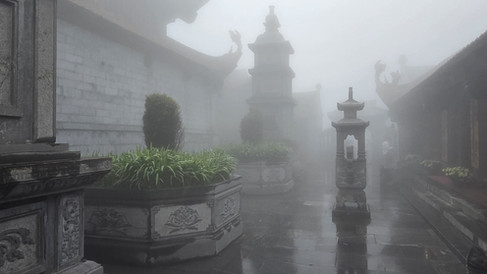The Myth and Majesty of Fansipan Mountain
- Shannon
- Jun 30
- 5 min read
Perched 3143 metres above sea level, Fansipan towers over the stunning Hoàng Liên Son mountain range & national park in northern Vietnam. Often called the “Roof of Indochina,” it is the highest point in the country and the broader Indochinese Peninsula. Yet its significance transcends far beyond altitude. Among the swirling clouds and ancient forest paths, Fansipan is a mountain shrouded in ancestral reverence, layered with wartime memories and wrapped in folklore as thick as its ever-present mist.

The mountain’s name gained prominence during the French colonial period in the early 20th century, when surveyors and explorers began mapping the area. Yet even colonial ambition could not subdue the terrain. For Vietnamese nationalists, Fansipan became a symbol of endurance and strength. Its wild beauty, unconquered spirit and refusal to yield to climbers or time has cemented its role as a natural monument of national pride. For decades, reaching the summit on foot required grit, respect and a guide who knew which slopes were cursed. The trek was not simply physical, it was spiritual, a journey undertaken by those who respected the mountain’s power and history.
Modern development has dramatically reshaped the way visitors access Fansipan. The installation of the Fansipan Legend cable car, inaugurated in 2016, has turned what was once a grueling multi-day trek into a swift, scenic ascent. Stretching approximately 6.3 kilometers in length and climbing a vertical height of over 1,400 metres, it holds Guinness World Records for the longest three-rope cable car and the greatest elevation gain by a cable car system. In just 15–20 minutes, passengers are transported from the Muong Hoa Valley near Sa Pa to close to the summit, gliding over lush forests, terraced rice fields, and remote villages. This engineering feat has not only opened the mountain to a broader demographic but has also established Fansipan as a leading spiritual and tourism hub in Vietnam, blending high-altitude adventure with cultural reverence.

At the summit, visitors now encounter a remarkable temple complex that blends Buddhist tradition with Vietnamese artistry. The most prominent feature is a 21.5-metre-tall bronze statue of the Great Buddha, seated seremenly in meditation above the clouds. Nearby, the Kim Sơn Bảo Thắng Pagoda stands proudly, its intricate design and ornate carvings offering a place for worship, reflection and offerings. Fragrant incense fills the air as temple bells echo across the windswept ridges. Stone stairways leading to the shrines are lined with dragon sculptures and stone lions, evoking both protection and majesty.

One of the most enduring legends surrounding Fansipan is that of the Sleeping Dragon, or “Rồng Ngủ,” a powerful myth passed down through generations by ethnic groups such as the Hmong and Dao. According to these traditions, the dragon once fiercely defended the region before finally coming to rest, its massive form becoming the very shape of the mountain. Its jagged ridges are said to be the creature’s spine and the swirling mists and sudden storms, its lingering breath. Intertwined with local animist and Buddhist beliefs, this tale transforms Fansipan into a living guardian whose presence demands both reverence and caution.

Another legend speaks of Linh Nương, a mountain goddess who, heartbroken by betrayal, retreated to the summit, her sorrow giving rise to the icy winds and dense fog that cloak the peak. In addition, villagers speak of ancient warriors whose spirits remain trapped beneath the stone, their mournful cries carried by storms, luring the unwary into treacherous ravines. Mysterious voices, flickering lights, and phantom footsteps reported by porters and locals add to the mountain’s haunted reputation, casting Fansipan as not merely a natural wonder but a place steeped in spiritual mystery and supernatural presence.
Fansipan is located within the Hoàng Liên National Park, one of Vietnam’s richest biodiversity hotspots. The varied climate zones, from subtropical forests at the base to alpine vegetation near the summit, nurture a range of ecosystems found nowhere else in the country. These distinct habitats support an extraordinary array of wildlife, many of which are endangered or endemic to this region. Among the rare animals that inhabit the park are the elusive red panda, the Asiatic black bear, the Indochinese tiger and the critically endangered Tonkin snub-nosed monkey.
This protected area is also home to more than1600 species of plants, including rare orchids and ancient conifers. Fansipan’s ecological significance is reinforced by the continued discovery of previously unknown species. As tourism grows and deforestation poses persistent threats, coordinated conservation efforts are crucial to preserving the mountain’s delicate habitats. These initiatives aim to protect not only the rare wildlife and ancient plant species that thrive here, but also to maintain Fansipan’s status as both a natural marvel and a sanctuary for Vietnam’s most vulnerable ecosystems.

Though some critics view the recent developments as a commercialisation of an ancient and untamed landscape, many locals welcome the project as a way to bring Fansipan’s sacred spiritual heritage into the modern era. The mountain now functions as a dynamic cultural landmark, where spiritual reverence, natural majesty and national identity converge. Despite easier access, Fansipan remains a place of stark dualities. It is both welcoming and formidable, spiritually rich yet physically demanding. Each day, hundreds ascend to its summit, yet the unpredictable climate, shifting fog, sudden gusts and biting cold, continues to assert the mountain’s wild temperament. Many visitors speak of an almost tangible presence in the quiet moments, as if the mountain itself demands respect rather than conquest.
Location : Fansipan, Hoàng Liên Sơn Mountain Range, Lào Cai Province, Sapa Town, Vietnam
How to get there : From the centre of Sapa Town, head to Sapa Station. From there, board the Muong Hoa mountain train, a scenic 6-minute ride that brings you to the Fansipan Legend Cable Car station. The cable car then takes you on a 20 minute journey covering 6.3 km and ascending over 1400 metres to the upper slopes of the mountain. At the top, you can either climb approximately 600 stone steps or take a final short funicular to reach Fansipan’s summit and its dramatic temple complex. I recommend getting the funicular right up to the top and then walking back down past all the temples, statues and pagodas to the cable car for your return visit down the mountain.
Attraction Info : Tickets for the Fansipan Cable Car can be purchased online through official platforms like Sun World Fansipan Legend or trusted travel sites such as Klook, which is recommended to avoid queues and ensure availability during busy periods. That said, they need to be bought on the day you intend to use them. Alternatively, you can buy tickets in person at the Sun World ticket office, at any of the surrounding cafe's or restaurants or through your hotel. Personally i found the online options to be unclear and would recommend getting a local to help you when you're there. Combo tickets range in price from 800,000 VND for adults and 550,000 VND for children. There is a decent sized restaurant at the top. As of 2025, the Fansipan Cable Car operates daily, opening from 7:30am - 5:30pm on weekdays, extending from 7am - 6pm on weekends and from 6:30am - 7pm on public holidays. The final return trip from the summit station departs at 5:30pm. Operating hours may vary slightly during special events or for maintenance, so it’s recommended to check ahead before your visit to avoid disruptions.

Official Website : https://fansipanlegend.sunworld.vn/en/
Thanks for reading The Myth and Majesty of Fansipan Mountain. Check out more destinations here!











































































